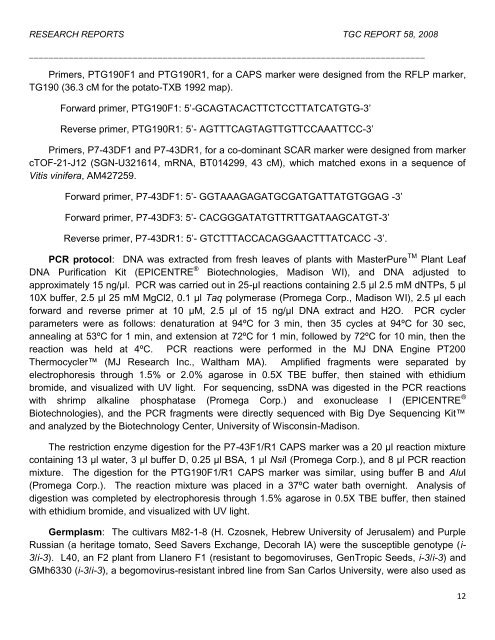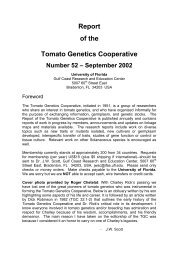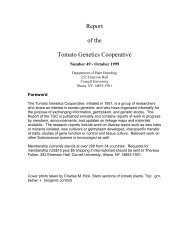Report of the Tomato Genetics Cooperative Number 58
Report of the Tomato Genetics Cooperative Number 58
Report of the Tomato Genetics Cooperative Number 58
Create successful ePaper yourself
Turn your PDF publications into a flip-book with our unique Google optimized e-Paper software.
RESEARCH REPORTS TGC REPORT <strong>58</strong>, 2008<br />
________________________________________________________________________________<br />
Primers, PTG190F1 and PTG190R1, for a CAPS marker were designed from <strong>the</strong> RFLP marker,<br />
TG190 (36.3 cM for <strong>the</strong> potato-TXB 1992 map).<br />
Forward primer, PTG190F1: 5‘-GCAGTACACTTCTCCTTATCATGTG-3‘<br />
Reverse primer, PTG190R1: 5‘- AGTTTCAGTAGTTGTTCCAAATTCC-3‘<br />
Primers, P7-43DF1 and P7-43DR1, for a co-dominant SCAR marker were designed from marker<br />
cTOF-21-J12 (SGN-U321614, mRNA, BT014299, 43 cM), which matched exons in a sequence <strong>of</strong><br />
Vitis vinifera, AM427259.<br />
Forward primer, P7-43DF1: 5‘- GGTAAAGAGATGCGATGATTATGTGGAG -3‘<br />
Forward primer, P7-43DF3: 5‘- CACGGGATATGTTRTTGATAAGCATGT-3‘<br />
Reverse primer, P7-43DR1: 5‘- GTCTTTACCACAGGAACTTTATCACC -3‘.<br />
PCR protocol: DNA was extracted from fresh leaves <strong>of</strong> plants with MasterPure TM Plant Leaf<br />
DNA Purification Kit (EPICENTRE ® Biotechnologies, Madison WI), and DNA adjusted to<br />
approximately 15 ng/µl. PCR was carried out in 25-µl reactions containing 2.5 μl 2.5 mM dNTPs, 5 μl<br />
10X buffer, 2.5 µl 25 mM MgCl2, 0.1 μl Taq polymerase (Promega Corp., Madison WI), 2.5 µl each<br />
forward and reverse primer at 10 μM, 2.5 μl <strong>of</strong> 15 ng/μl DNA extract and H2O. PCR cycler<br />
parameters were as follows: denaturation at 94ºC for 3 min, <strong>the</strong>n 35 cycles at 94ºC for 30 sec,<br />
annealing at 53ºC for 1 min, and extension at 72ºC for 1 min, followed by 72ºC for 10 min, <strong>the</strong>n <strong>the</strong><br />
reaction was held at 4ºC. PCR reactions were performed in <strong>the</strong> MJ DNA Engine PT200<br />
Thermocycler (MJ Research Inc., Waltham MA). Amplified fragments were separated by<br />
electrophoresis through 1.5% or 2.0% agarose in 0.5X TBE buffer, <strong>the</strong>n stained with ethidium<br />
bromide, and visualized with UV light. For sequencing, ssDNA was digested in <strong>the</strong> PCR reactions<br />
with shrimp alkaline phosphatase (Promega Corp.) and exonuclease I (EPICENTRE ®<br />
Biotechnologies), and <strong>the</strong> PCR fragments were directly sequenced with Big Dye Sequencing Kit<br />
and analyzed by <strong>the</strong> Biotechnology Center, University <strong>of</strong> Wisconsin-Madison.<br />
The restriction enzyme digestion for <strong>the</strong> P7-43F1/R1 CAPS marker was a 20 μl reaction mixture<br />
containing 13 μl water, 3 μl buffer D, 0.25 μl BSA, 1 μl NsiI (Promega Corp.), and 8 μl PCR reaction<br />
mixture. The digestion for <strong>the</strong> PTG190F1/R1 CAPS marker was similar, using buffer B and AluI<br />
(Promega Corp.). The reaction mixture was placed in a 37ºC water bath overnight. Analysis <strong>of</strong><br />
digestion was completed by electrophoresis through 1.5% agarose in 0.5X TBE buffer, <strong>the</strong>n stained<br />
with ethidium bromide, and visualized with UV light.<br />
Germplasm: The cultivars M82-1-8 (H. Czosnek, Hebrew University <strong>of</strong> Jerusalem) and Purple<br />
Russian (a heritage tomato, Seed Savers Exchange, Decorah IA) were <strong>the</strong> susceptible genotype (i-<br />
3/i-3). L40, an F2 plant from Llanero F1 (resistant to begomoviruses, GenTropic Seeds, i-3/i-3) and<br />
GMh6330 (i-3/i-3), a begomovirus-resistant inbred line from San Carlos University, were also used as<br />
12





